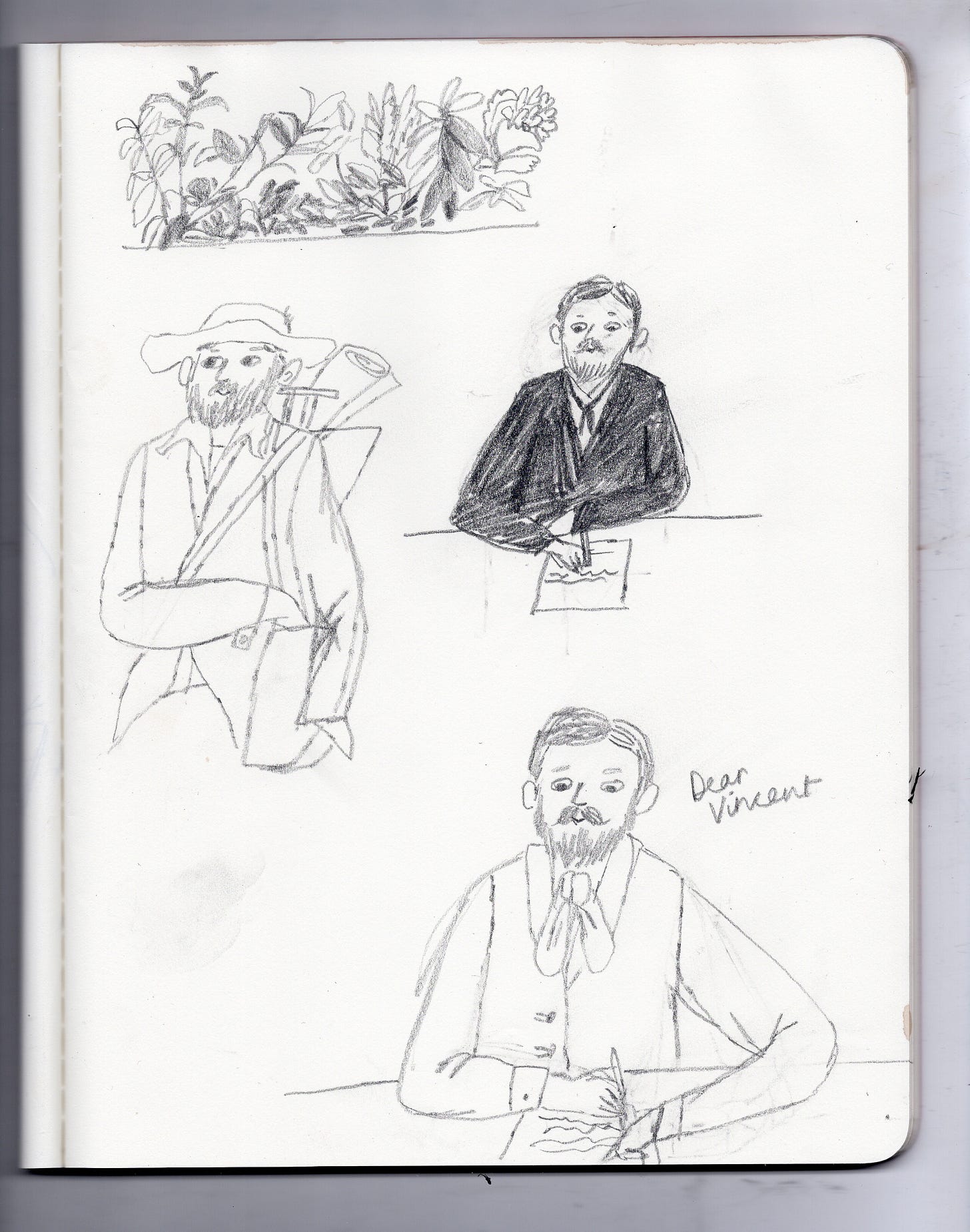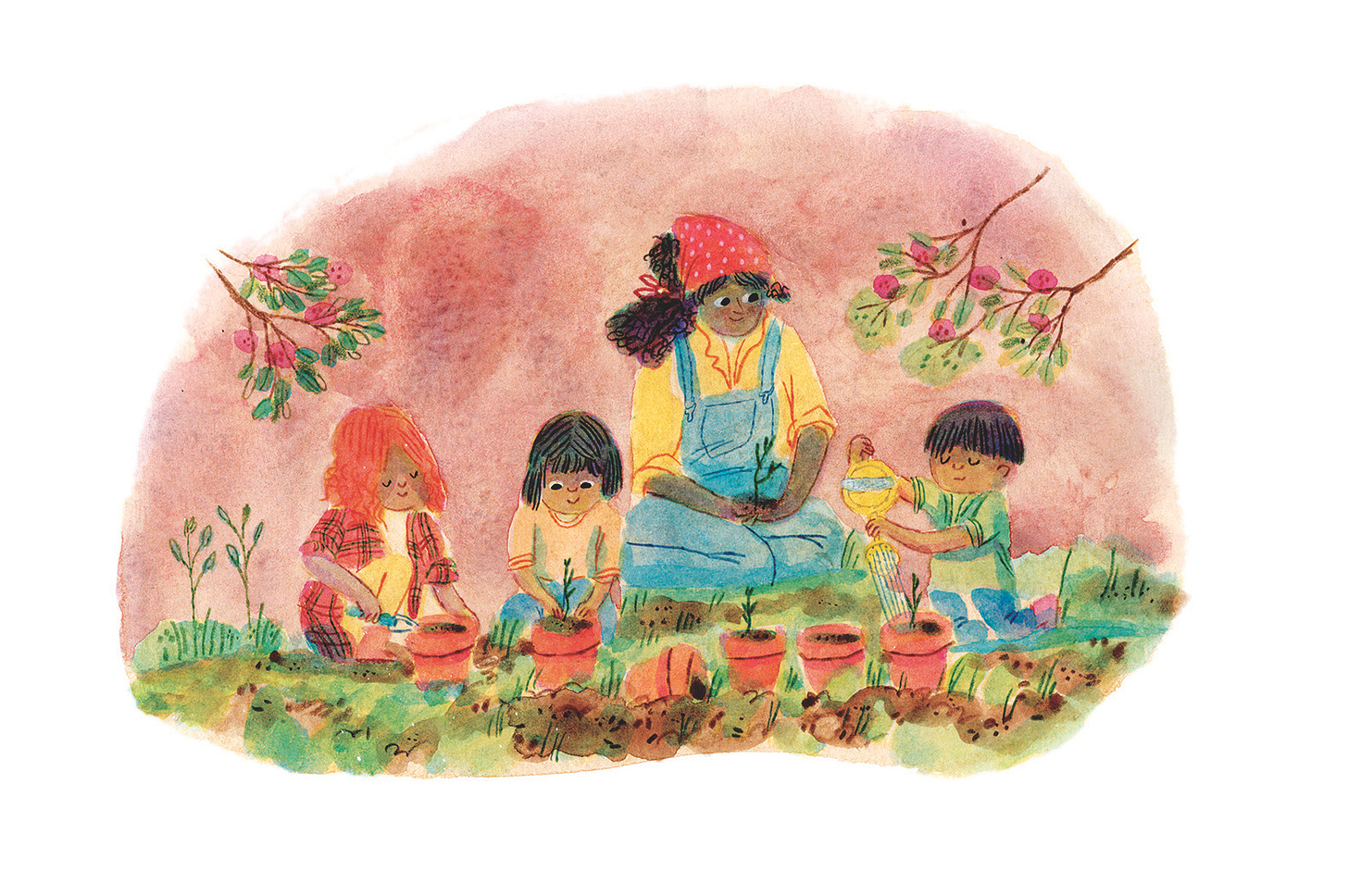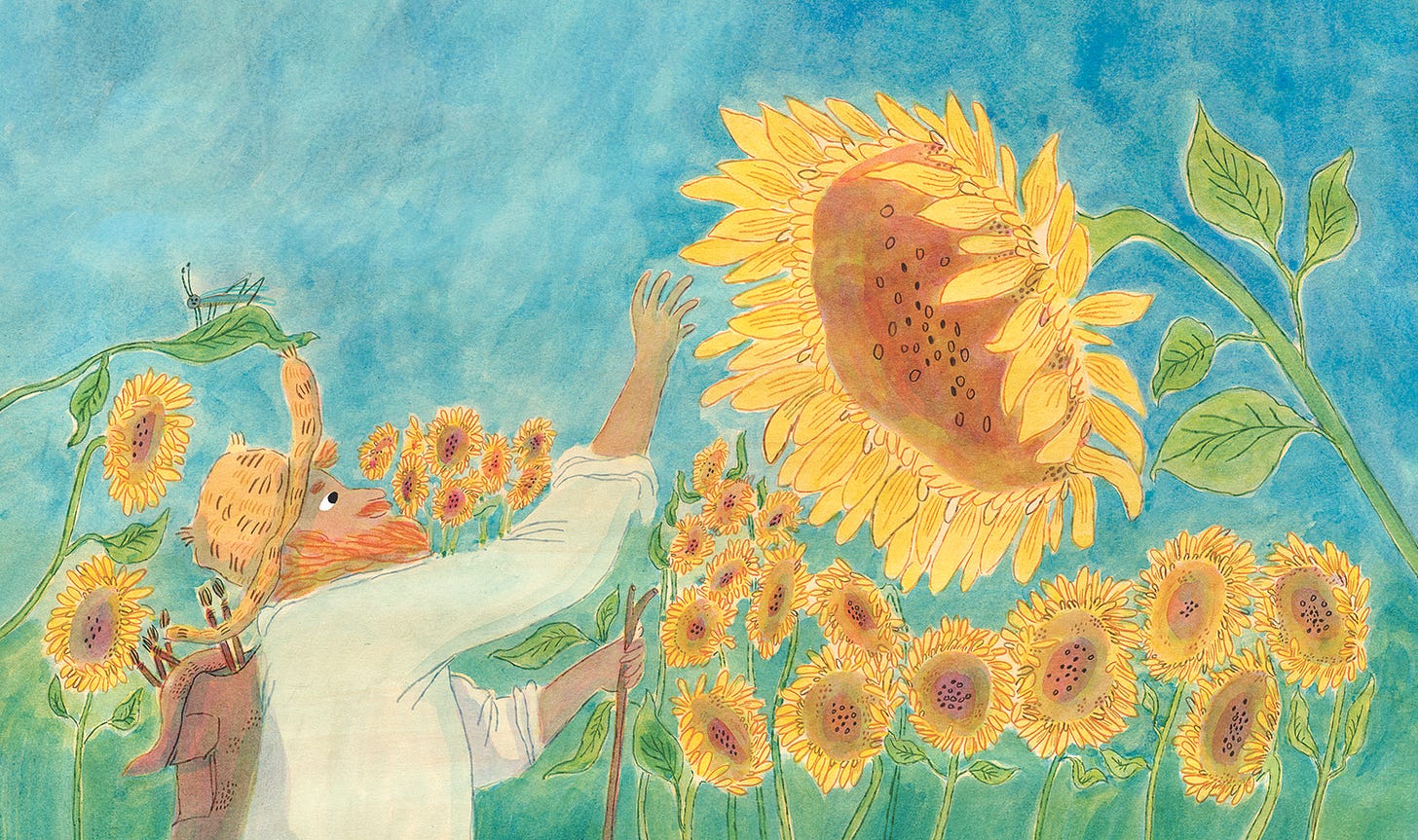Three “hacks” I use to help me be a better illustrator
or... how I craft things to work for me, not against me
Hello!
Apologies for the clickbait title! This is a post that I have dreamed up in the space around the edges. You know, all those times you are letting your mind wander… In the shower, brushing your teeth, putting on your pants. When you don’t even really know you’re thinking, these are the thoughts that pop up. So I started noting them down on my phone, and hey presto! - they have become this post! I couldn’t resist the title - it’s a sort of rebellious nod to all those clickbait posts you get telling you I did this, and it changed my life! These are all things that genuinely have made a big difference to my practice. And they aren’t miracle fixes; they’ve taken years - of mistakes, failures, frustration - and dare I say tenacity, too! - and optimism; of trying again; hoping; dreaming…!
What I’m saying is - these most probably won’t be a quick fix for you; but I hope they might be things that you too find yourself pondering in the space around the edges. You might change the way you’re thinking about things and this might lead to a change. I hope so! One of the things I say to the students on the MA1 is: learning who you are, how you work, and what works best for you is one of the best things you can do for your practice. Once you start thinking about things like this, everything else takes care of itself. I would even put it above and beyond skills. The most important thing of all is that you are able to actually show up and make, in a way, everything rests on this!
And to do that, you need to know all your creative foibles, your weird and wonderful quirks that help you make. Like an old rusty car, which you need to nudge with your hip before it opens, or wiggle the key before it starts.
These are the things I’ve learned work for me at the moment, and I hope by sharing them, they will spark you to think about your own - and I’m hoping they will resonate and spark conversation too.
Ok, so on with the show!
Are you enjoying this post? To celebrate the coming of summer, the UK month of Bank Holidays ( AKA May) I am offering 50% off paid subscriptions forever! Just sign up using the link below! All subs help me to continue making illustrated books, and creating posts here on Substack. And as well as supporting me, you get benefits too. What?! Yes, you heard me! You get access to my big back catalogue of paid posts, and access to my monthly Zoom sessions: Art Club and Picture Book Club. And if you can’t attend live, all sessions are recorded and posted afterwards.
ONE
Setting my daily “enough” standards
Guilt - it’s a killer. And it’s so easy to feel guilty as a freelance illustrator. Because there are no set hours, I can feel like I should be working all the time.
I’m naturally a faffer when I start the day. I like to feel ready, fuelled, awake; like I’ve got everything lined up and ready to go. I find it hard to leave an email unanswered, and I like to sit and check in when I begin the day, generally at my computer. And if I’m honest, I can be prone to faff, meander, wander aimlessly, pick things up and put them down again, get distracted by a “busy” task, like tinkering with my website.
I used to feel guilty about this. Like I should stroll into my studio, switch the light on, and get straight to creative work. But in the years since I’ve been freelance, and actually, going further back than that, thinking back to work too, I have learned that once I do start work, one of my super-powers is that I work efficiently and deeply, and I will produce a lot in a concentrated, intense focus. I think it’s often referred to as hyper focus, and I see it as my friend and superpower! I know that once I get going, I will get plenty of work done in a burst of creative energy.
And afterwards, I am spent - done! In fact, this is the thing I have to watch for: being able to stop and pull myself out of the focus, because if I’m not careful, it tips over from super-power to dangerous energy drainer. I always feel like I am skating the fine line between being great at getting work done and burnout. This leads me to my “hack”, which is simply that the standard I set for myself every day is to get 4-5 hours work done. But it’s more than that - it’s a belief in myself - that once I get going, I will get the work done. I know, and believe I am good at getting work done, despite being a faffer; they co-exist happily together.
This means that the faffing I invariably do at the beginning doesn’t make me feel guilty; even a whole morning of it won’t, because I know that once I get going, I am super efficient and focused. I believe that letting go of the guilt means that the working day doesn’t feel like a burden, or overwhelming, because I am allowing myself faffing time, guilt free and I’m setting myself a target that doesn’t feel like a burden. I think if I said I have to work from 9 - 5, sat at my desk, I would feel trapped, and therefore avoidant. One of the (other, and many) things I have learned about myself is that having space to flex keeps me from feeling too hemmed in and trapped, and this helps me create the best, least draining working ritual for me.
TWO
My 60% rule
Another thing I have learned about myself over the years is that I am a perfectionist. I remember using it as a “weakness” in an early job interview, which I have learnt subsequently is a cheesy2 answer - but I stand by it. I know I’m not saying anything new here, and I’m not the first creative person to talk about it - but humour me! Let me tell you about my particular brand of perfectionism, and I’ll tell you about the brilliant “hack” I use to help overcome it.
Ok, so my perfectionism shows as a tenacity and drive to make something the “best” it can be. It is both my enemy and friend (frenemy!). I can see that having high standards can be a good thing. I am that student/employee/illustrator who likes to be given directions and pushed; I find it exciting and motivating, and on the whole, I think it’s always worth trying out someone’s idea. It means that I work hard to please my boss/teacher/publisher, which can be good for getting along with everyone, progressing and achieving high standards (with many caveats here!). On the other hand, I can end up losing sight of my own vision for something, and here we come back to that burnout again. I can push myself so hard that I take something right up to edge - of my energy and the deadline.
This is not so good for the boss/publisher/teacher either - what’s the good of working diligently to make something as good as possible if it’s late, or right up to the wire?
This shows up the most in my illustration with my desire to redo things; to re-draw sketches; to repaint things I’ve already painted, and, most of all, by making the standards I set for myself so high that I invariably feel unhappy with what I’ve done. I’m always looking for ways to improve or rework, and it just doesn’t switch off. So when I run into a deadline (as you inevitably do in publishing) I am left with a feeling of disappointment and discomfort. That desire to redo and dissatisfaction with the outcome can be super intense, and I feel an unease and worry right up until publication. Will people think it’s as awful as I do? Will they spot that thing I have been obsessing over? Then, woosh, out it goes into the world, and everyone is always SO NICE about it! There’s something about publication that feels like a full stop and, more importantly, I am able to overlook (on the whole) all the things I want to change and start to see it as a book - as a whole. In the past. I begin to see my illustrations as a family that belong to each particular book. Do I think they are the best they can possibly be? Maybe not, but they are all related: the drunken uncle, the favourite cousin, etc etc…!
Which takes me to my “hack”. I was talking to a friend about this (who also happens to be a therapist and life coach!) and she asked me: how happy do you have to be with something for other people to like it? I thought about it and came up with a number: 60%
Yes - 60%!
It felt low, but on the other hand, what a powerful thing for helping my perfectionism! If I am 60% happy with something (and let me tell you, I want to be closer to 80-90% happy!!) everyone else loves it! It became my super helpful way to “let go” of the many things I feel dissatisfied with toward the end of a book. I often ask myself now: am I 60% happy with it? Sometimes it’s more, often it can be close to 60%, and if it really is under 60% I feel empowered to do it again.
I hope that’s as powerful for you as it is for me! What’s your percentage?
Are you enjoying this post? To celebrate the coming of summer, the UK month of Bank Holidays ( AKA May) I am offering 50% off paid subscriptions forever! Just sign up using the link below! All subs help me to continue making illustrated books, and creating posts here on Substack. And as well as supporting me, you get benefits too. What?! Yes, you heard me! You get access to my big back catalogue of paid posts, and access to my monthly Zoom sessions: Art Club and Picture Book Club. And if you can’t attend live, all sessions are recorded and posted afterwards.
THREE
Know thy self
Here we come back to the word should. It’s such a powerful word to torture yourself with. I should be working like this, I should be feeling like this, I should be doing this…
Like many a creative before me, I have spent much time looking over my shoulder; I’m metaphorically sitting in the exam, bent over my paper, trying to side-eye my way to my neighbour to see how much they have written. It can be hard to measure your own success purely by judging yourself in isolation. But it was learning to pull myself back from the comparisons and shoulds that led to my biggest leap forward on the MA - the elusive breakthrough!
I remember the moment so clearly. I was in my studio, and was feeling disappointed - yet again - with what I had done. I had been through a particularly intense period of looking at everyone else’s work and comparing myself unfavourably. It was like my work had no value unless it was measuring up to something else. I was trying too hard, but I wasn’t sure what I was trying to achieve, other than being “good” - and more importantly, as good as x or y. But in this particular moment, that stands out so clearly in my memory, something changed. It was towards the end of the MA; I had completed 3 modules and was on the last one - the big one - the one that’s worth double the marks of the other modules: “Masters Stage”. No pressure then!
I was, of course, feeling massively pressured, as everyone invariably does. I’d been trying so hard to produce work I felt happy with. On the one hand, I was amazed and proud that I had produced any sort of illustration at all; before the MA, I had never made anything from my imagination - I was purely an observational artist. I could draw or paint something if it was right in front of me, but to illustrate a story from words that I have written? I was genuinely terrified of it. So in that sense, I was amazed every time I did anything! And proud. On the other hand, there was that perfectionist, saying: It’s not good enough. It’s not as good as <insert famous illustrator here> therefore it’s no good at all! So we come back to this particular afternoon in my studio. I remember having this weary moment of: I guess I’ll just have to be myself… It was an: I give up! moment. Why do some moments have such impact? I don’t know. But something shifted after that. I remember thinking: although I find my drawings disappointing, this is what I am producing. Why don’t I just accept them?!.
I stopped trying to be other people, trying to be an illustrator, and just allowed my raw, authentic drawings to emerge. I worked on them, refined them. They actually got “better” or should I say, I became more fluent, I made better choices. Once I allowed myself to make my ”shit” drawings, I actually started making better drawings! Ironic, eh? It was soon after that that I had my breakthrough. I was working on a couple of the spreads for my Master’s project, and I was making and assessing it against what I was trying to achieve. I wasn’t thinking: what would x or y do?, but what do I think I should do. It took a few weeks - working through that tenacious, perfectionist cycle, but this time I was reflecting inwards, on everything I had learned on the MA. And it was during that period I found my creative voice!!
As I write this, I realise how interlinked these all are, but all with their own unique flavour. They are all about a mindset shift, a letting go. And I guess, as I said, about knowing myself, and trusting myself.
I hope you have found this helpful - I’d love to know if it resonates, and what weird and wonderful quirks help you!
Until next time!
Ella xx
Psst! Did you enjoy this? To get more of these, and become part of my community, join my paid membership for 50% off - it’s utter May Madness!
I teach as an associate lecturer on the Children’s Book Illustration MA at The Cambridge School of Art.
I can’t think of a better word for this. cheat’s answer?










Love that 60% rule! I'm more of an 80-90% person, too, but I like the idea of having a "good enough for other people" standard to guide me.
I found this really helpful, thank you!